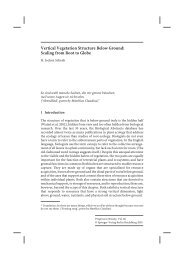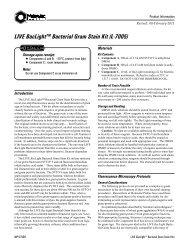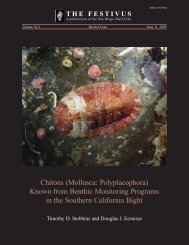Landscape Evolution at an Active Plate Margin - Biological Science ...
Landscape Evolution at an Active Plate Margin - Biological Science ...
Landscape Evolution at an Active Plate Margin - Biological Science ...
Create successful ePaper yourself
Turn your PDF publications into a flip-book with our unique Google optimized e-Paper software.
Day 2<br />
Theme: Glaciers <strong>an</strong>d snow where the hot<br />
springs flow<br />
with contributions from: D. R. Jessey, Steve Lipshie, R. E. Reynolds,<br />
J<strong>an</strong>et Westbrook, <strong>an</strong>d Tom Schweich<br />
Start Day 2<br />
Wh<strong>at</strong> We Will See: Our 130 mile route north of Owens<br />
Valley through Round Valley <strong>an</strong>d into the Long<br />
Valley Caldera will reach elev<strong>at</strong>ions of 7,000 feet,<br />
as we travel parallel to the Sierra crest with average<br />
heights of 12,000 feet. The Long Valley Caldera contains<br />
numerous hot springs, evidence of fumaroles,<br />
<strong>an</strong>d signs of hydrothermal alter<strong>at</strong>ion. Timber, minerals,<br />
rock commodities, <strong>an</strong>d w<strong>at</strong>er—hot <strong>an</strong>d cold—<br />
have been exploited over the last 160 years. Our route<br />
crosses eastern Sierra c<strong>an</strong>yons where evidence of the<br />
powerful forces of Ice Age glaciers remains.<br />
0.0 (0.0) Line St. in Bishop.<br />
0.5 (0.5) Visitor center <strong>at</strong> Y<strong>an</strong>ey Street. Move to the<br />
right l<strong>an</strong>e.<br />
0.8 (0.3) CONvENE <strong>at</strong> Gi<strong>an</strong>t Sequoia Tree <strong>an</strong>d the<br />
3 Flags <strong>at</strong> the intersection of highways 395 <strong>an</strong>d 6.<br />
Sequoias were pl<strong>an</strong>ted in 1918. There are seven in Big<br />
Pine, more th<strong>an</strong> 25 in Bishop, three in Independence,<br />
<strong>an</strong>d <strong>at</strong> least one in Lone Pine.<br />
Bishop, CA, founded in 1864, has a popul<strong>at</strong>ion of approxim<strong>at</strong>ely<br />
4000. The town was named after Bishop<br />
Creek; the creek was named after Samuel Addison<br />
Bishop, a c<strong>at</strong>tle r<strong>an</strong>cher in the Owens Valley. The city<br />
of Bishop calls itself the “Mule Capital of the World”<br />
<strong>an</strong>d hosts a festival called Mule Days over the Memorial<br />
Day weekend.<br />
BEAR RIGHT <strong>at</strong> traffic light <strong>an</strong>d PROCEED<br />
NORTH on Highway 6 when it intersects with Highway<br />
395.<br />
1.8 (1.0) Bear right on Hwy 6 <strong>at</strong> Dixon L<strong>an</strong>e.<br />
2.1 (0.3) Continue past Five Bridges Road on Hwy 6.<br />
4.6 (2.4) Cross the Owens River. Pass Silver C<strong>an</strong>yon<br />
Road, which leads to the Laws Railroad Museum, on<br />
the right.<br />
6.1 (1.5) Continue past Je<strong>an</strong> Bl<strong>an</strong>c Road. Highway 6<br />
bears north.<br />
8.5 (2.4) Prepare for left turn.<br />
8.7 (0.2) TURN LEFT on Rudolph Road to the Chalf<strong>an</strong>t<br />
Quarry. If you pass a Mono County sign, you’ve<br />
D. R. Jessey <strong>an</strong>d R. E. Reynolds<br />
gone too far.<br />
9.5 (0.8) BEAR RIGHT as road forks (NW).<br />
9.6 (0.1) BEAR LEFT to the quarry.<br />
9.8 (0.2) STOP 2-1. Chalf<strong>an</strong>t Quarry (N 37°27’36.1”;<br />
W 118°21’58.3”). The Bishop Tuff, d<strong>at</strong>ed <strong>at</strong> 760 ka,<br />
was produced by a 6-day-long eruptive event from<br />
the Long Valley Caldera (Hildreth <strong>an</strong>d Wilson, 2007).<br />
Air-fall ash remn<strong>an</strong>ts have been found from western<br />
California to Nebraska, <strong>an</strong> area of 1 x 10 6 mi 2 .<br />
Pyroclastic flows spread 40 miles to the southeast<br />
down Owens Valley, 20-30 miles east to the White<br />
Mountains <strong>an</strong>d 30–50 miles north into Mono Basin.<br />
The caldera collapsed into <strong>an</strong> 8 mi x 14 mi elliptical<br />
depression. It has been was subsequently enlarged<br />
by slumping <strong>an</strong>d erosion to its current 11 mi x 20 mi<br />
dimension.<br />
The Bishop Tuff consists predomin<strong>an</strong>tly of biotite–<br />
plagioclase–quartz–s<strong>an</strong>idine high-silica rhyolite. Ash<br />
fall deposits are plini<strong>an</strong> pumice lapilli <strong>an</strong>d crystalrich<br />
ash. Ash flows, as thick as 500 ft, r<strong>an</strong>ge from<br />
nonwelded to eutaxitic, <strong>an</strong>d from unconsolid<strong>at</strong>ed, or<br />
welded vitric zones to fully devitrified zones (Hildreth<br />
<strong>an</strong>d Wilson, 2007). Eruptive volume is not well<br />
known but Hildreth <strong>an</strong>d Wilson (2007) estim<strong>at</strong>e th<strong>at</strong><br />
150 mi 3 of magma was erupted to produce the Bishop<br />
Tuff.<br />
Two main major units of the Bishop Tuff deposit<br />
are visible here (Fig. 2-1). The lower 12 feet<br />
of the section consists of the poorly-sorted airfall<br />
tuff th<strong>at</strong> was deposited downwind from the<br />
Figure 2-1. Two units of the Bishop Tuff exposed <strong>at</strong> the Chalf<strong>an</strong>t<br />
Quarry. The lower 12 feet of the section consists of airfall pumice,<br />
<strong>an</strong>d the upper 15-18 ft of the section is comprised of the basal<br />
portion of a thick pyroclastic flow. The dark layers just below<br />
the contact are m<strong>an</strong>g<strong>an</strong>ese oxide stains caused by groundw<strong>at</strong>er<br />
circul<strong>at</strong>ion. [Source: http://lvo.wr.usgs.gov/]<br />
30 2009 Desert Symposium
















